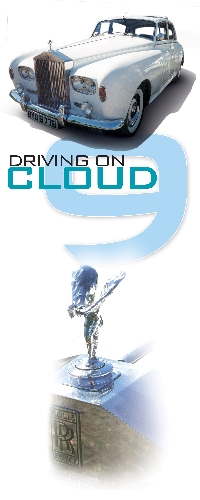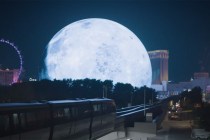Rolls-Royce likened to rolling sculpture
Charles Stewart Rolls and Henry Royce began creating their rolling vestiges of extreme wealth, power and fame more than 100 years ago. However, the total number of Rolls-Royce vehicles built barely equals a month's worth of production at General Motors Corp. today.
But what the company lacks in quantity, it more than makes up for in opulence and pedigree. As a direct result, the Rolls-Royce marque enjoys a loyal following among the elite of society. With sufficient funds, well-heeled customers can order their Rolls-Royce any way they please, including the use of custom coachwork, specially constructed interior appointments and unique paint. Hand over the check and your whim is the company's command.
Over the years Rolls-Royce motorcars have been used not only as luxury carriages, but also as armored vehicles and ambulances during World War I. Rolls-Royce-powered aircraft also helped Britain turn back the Luftwaffe, as Nazi Germany attempted to control the skies over England in the early days of World War II.
Rolls-Royce automobiles such as the Silver Ghost, Phantom, Silver Dawn and Silver Wraith have helped establish the company's tradition of excellence. But it is the Silver Cloud series that became the backbone of the company. Over a 10-year period, from 1955-'65, nearly 7,500 Silver Clouds were produced (not including the nearly identical Bentley S-Types), the closest thing to mass production of a Rolls-Royce automobile.
The Silver Cloud I, launched in 1955, was a big (212 inches long) and hefty (4,400 pounds) piece of rolling sculpture. Power came from a 4.9-liter flathead six-cylinder engine that was originally designed in the 1930s. To enhance the car's mystique, Rolls-Royce declined to provide a horsepower rating for its engines (about 175 is a fair estimate), simply describing output as "sufficient."
The first Silver Clouds (mostly sedans, but also a limited number of specially made coupes and convertibles) came with a four-speed manual transmission or four-speed Hydramatic automatic that Rolls-Royce built under license from General Motors. However, after a year and a half, the far less popular manual gearbox was dropped from the list.
On the inside, each Silver Cloud had finest Connolly leather hides covering overstuffed chairlike seats, Wilton carpeting and burled-walnut interior trim. Included inside the trunk, or "boot," was a tool kit that allowed the owner, or perhaps the chauffeur, to perform rudimentary maintenance or repairs to the car.
The Silver Cloud's body, attached separately to a girder-style chassis, was beautifully crafted by the Pressed Steel Co. of Oxford, England. The rear roof-support pillar on the sedans was designed extra wide to allow privacy for those occupying the rear seats. To reduce weight, the car's doors, trunk and hood were hand-formed of aluminum. The latter item was hinged along the middle, allowing access to the engine from either side of the car.
After applying 12 coats of hand-rubbed lacquer paint, the famous Rolls-Royce "Flying Lady" mascot (the actual name was the Spirit of Ecstasy) was attached to the top of the Silver Cloud's distinctive silver-coated radiator shell.
Despite the relatively large number of cars produced, each Silver Cloud took three months to complete. Once on the road, though, the fortunate owner was treated to a smooth, quiet ride and the silent purring of the well-dampened powerplant. Stopping power was provided by drum brakes, deliberately selected instead of disks since they tended not to squeal.
The Silver Cloud II replaced the initial version in 1959. The car featured an all-new 6.2-liter V-8 (worth about 200 horsepower) that was similar to a design Cadillac had adopted 10 years earlier. About 300 of the more than 2,700 Silver Cloud IIs made were special longer wheelbase limo models, with custom bodies by coach builders such as H.J. Mulliner and James Young.
The Silver Cloud II gave way to the Silver Cloud III in 1962. Aside from a slightly lower hood and radiator, this model came with quad headlights -- a very controversial change in those days -- a feature that was roundly criticized by Rolls-Royce purists. The aluminum V-8 also received a slight increase in horsepower (estimated at 220) which produced zero-to-60-mph times of 11 seconds and a maximum speed of close to 120 mph. Not bad for a car weighing well in excess of 2 tons.
Ultimately, all good things must come to an end, and so it was with the Silver Cloud when the last of the series IIIs left the Crewe, England, factory in 1965. The car's distinctive long hood, sensuous fenders and gently sloping rear deck were replaced by the much blander-looking Silver Shadow.
Today, the automotive division of Rolls-Royce is owned by BMW, while the Bentley name is owned by Volkswagen. To possess a "base model" Rolls-Royce Phantom, you'll have to cough up at least $385,000 -- many times the price of a final-year Silver Cloud.
Then, as now, the price of trumpeting your success and good fortune doesn't come cheap.
Malcolm Gunn is a feature writer with Wheelbase Media. He can be reached on the Web at www.wheelbase.ws/media by clicking the contact link. Wheelbase supplies automotive news and features to newspapers across North America.















